Goldendoodles have the most gorgeous fur! But that beautiful coat does tangle quite easily and even straight hair Goldendoodles can suffer from matting and the skin issues that causes.
So, what can you do if your pet’s fur becomes tangled and matted? Can matted hair cause health problems for your Goldendoodle? And how can you prevent your Goldendoodle’s hair from becoming matted in the first place?
In this detailed guide, we explain how to deal with Goldendoodle matted fur painlessly and effectively.
Table of Contents
What Is Matted Goldendoodle Fur?
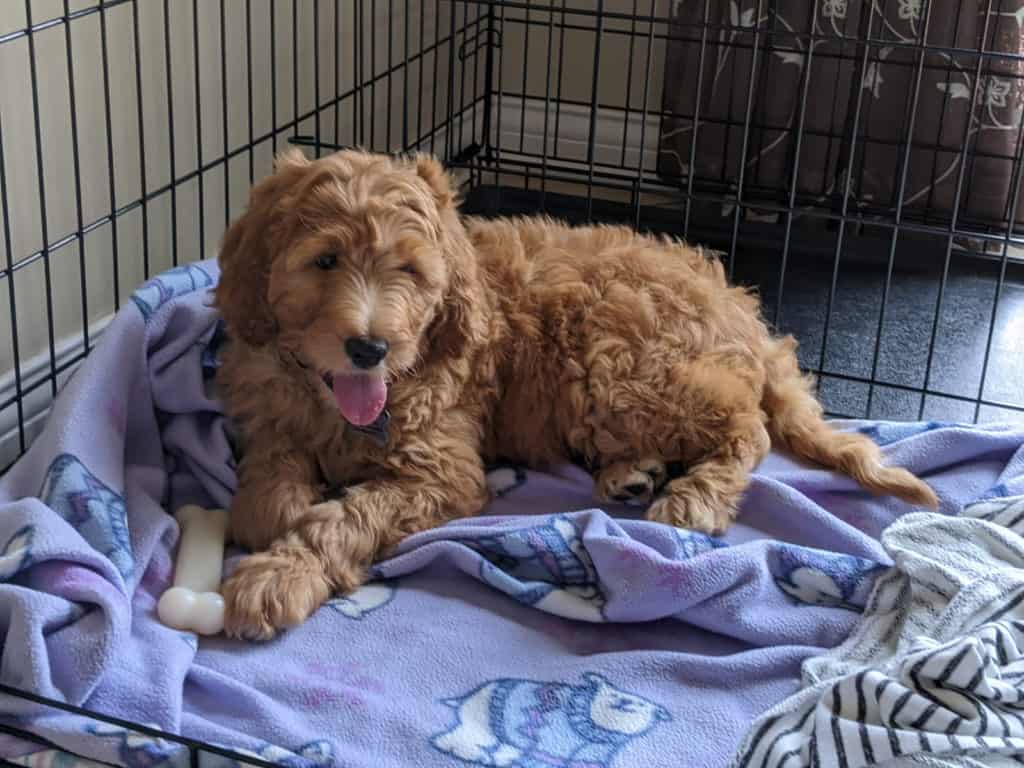
Matting is the term that’s used to describe severe, dense knots and tangles in the dog’s underfur. Mats are different to surface knots and tangles because the matted fur extends right down to the skin.
Some dogs have high-maintenance coats that are more vulnerable to matting than others. However, any dog with long hair can get tangled fur, especially those with double coats.
Does Matted Hair Hurt Goldendoodles?
Mats can quickly develop into a painful condition that can cause other health concerns, such as painful skin irritation, lesions, and infections. Matted fur also covers up other health problems and provides shelter and a breeding ground for parasites.
Thick, matted hair effectively prevents the proper airflow through and underneath the dog’s fur, trapping moisture. That can cause skin irritation and trigger ulcers, skin sores, and other health issues. Even very mild matting can be uncomfortable for your dog, but in severe cases, mats can cut off the blood circulation to your dog’s skin, causing hematomas.
When the fur is severely matted around the dog’s rear end, an accumulation of feces can develop, even preventing the dog from defecating. In very severe cases, mats can surround a dog’s limb, cutting off the blood supply and even slicing through the tissues right down to the bone so that the limb requires amputation.
What Causes Matting?
There are several causes of matting in dogs, all of which are preventable:
Friction
Mats generally form on parts of the dog where the most friction occurs. Friction causes the hair to tangle so that it forms a hairball. The hairball gets larger and denser until it forms a mat.
Those areas include:
- where the dog’s collar or harness sits
- the armpits
- the legs where the dog lays down or comes into contact with wet grass
- behind the dog’s ears or other areas where the dog scratches itself
Seasonal conditions
Goldendoodles have a double coat. The underfur is soft and fluffy and works as insulation. keeping the dog warm in the winter and protecting the animal from the sun’s harmful UV rays during the summertime.
The outer coat of guard hairs is longer and coarser, basically providing water-proofing for the underfur.
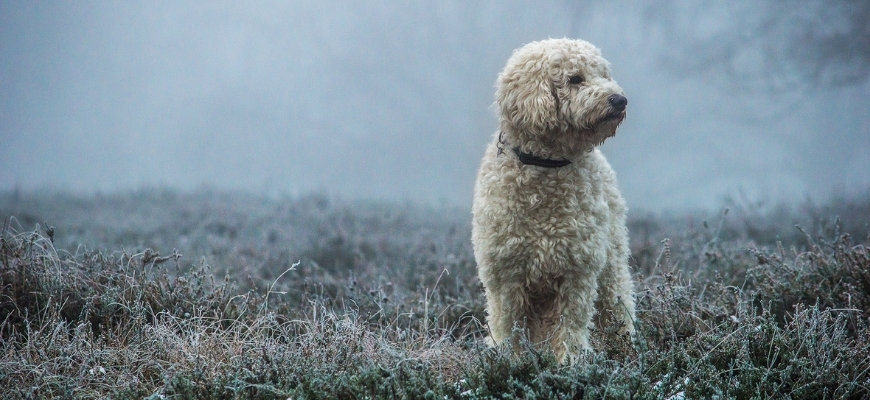
Although light shedding occurs all year round, in the spring and fall, the underfur is shed more heavily in a process referred to as “blowing” the coat.
If you don’t brush your Goldendoodle to remove the loose underfur, fur mixes with dander, forming dense clumps of hair that effectively become a breeding ground for tangles and mats.
Dogs With Allergies
Some Doodles are prone to developing skin allergies, including sebaceous adenitis. The condition irritates the skin, causing itching and hair loss, so the dog scratches and licks at the area, causing his beautiful hair to tangle and eventually become matted.
Flea Infestation
If the Doodle has fleas, the irritation the parasites cause leads to scratching and matted fur. Unfortunately, thick mats create a dark, warm, damp environment that’s perfect for flea colonies to become established, creating a vicious circle.
Wet Hair
Goldendoodles are water babies that love to swim when they get a chance! Even rolling in wet grass can lead to matted hair.
When bathing your Goldendoodle, you must always brush his hair thoroughly first, as getting matted fur wet will make the problem worse.
How To Know If Your Goldendoodle Has Mats
Mats are almost always easily noticeable by touch and as a responsible Doodle owner, you need to know that. As you’re stroking your pet, you might find that your fingers get trapped in his hair. Try as you might, no amount of teasing or pulling won’t split that hairball.
Large mats can usually be seen, as they often part the hair and can clearly be seen. However, sometimes, those lumps of hair are hidden and go unnoticed until the mats cause your pet a serious problem.
How to Detangle Goldendoodle Hair
You can prevent mats from forming by dealing with minor coat tangles as soon as they appear.
Be sure to brush your dog every day, right down to his skin. Include the dog’s head, legs, and tail, paying particular attention to problem areas, such as underneath the collar, armpits, between the back legs, and behind the ears.
Most tangles can be removed easily with a metal comb or by gently teasing the hair apart with your fingertips. Add a spritz of a high-quality coat detangler (or a conditioner spray) to make the ends of the hair smooth and comb through.
How To Remove Mild Hair Mats From Your Goldendoodle’s Fur
If you do find a knot of hair in your Doodle’s coat, don’t panic! With the right products and patience, you can usually remove minor mats from your pet’s fur.
What You Will Need
The right tools for the job are essential when it comes to dealing with matted fur.
Basically, to tackle small mats, you need a metal comb and some corn starch. You’ll also need treats and a toy to distract your dog while you’re working.
How To Do It:
Here’s how to tackle small mats in your Goldendoodle’s fur.
Do not bathe your dog! As mentioned earlier, getting your dog’s coat wet will only make it more difficult to remove tangles and mats.
- Once your dog is busy playing with his toy, you can begin to work on the mat.
- Hold the mat in your fingers close to the skin. Rub some corn starch into the matted hair. Use your fingers to tease out as much of the tangled hair as you can.
- Start at the tip of the fur and begin to comb it gently. The slippery corn starch helps the comb to slide through the hair without catching or pulling.
- Work toward the root of the hair, using more cornstarch as you work if necessary. Remember to keep praising your dog and be very careful not to pull on the hair.
Once you’ve got rid of the mat, groom your dog thoroughly.
What Can You Do For A Severely Matted Goldendoodle?
If you brush and groom your Goldendoodle correctly and keep his coat clean, you should never have to deal with very severe mats.
However, if you do discover any very nasty tangles and mats on your pet, do not try to tackle them yourself. Pulling and tugging at the mats won’t shift them and is extremely painful for your pet. You might even cause hot spots to form on your Doodle’s skin.
Also, don’t be tempted to try to cut the mats off. That can also be very painful for your dog, and if your dog jumps, you could finish up cutting him with the scissors.
Goldendoodle Shaving
In very severe cases of matting, the best course of action is to take your pet to a professional groomer and have your Doodle shaved.
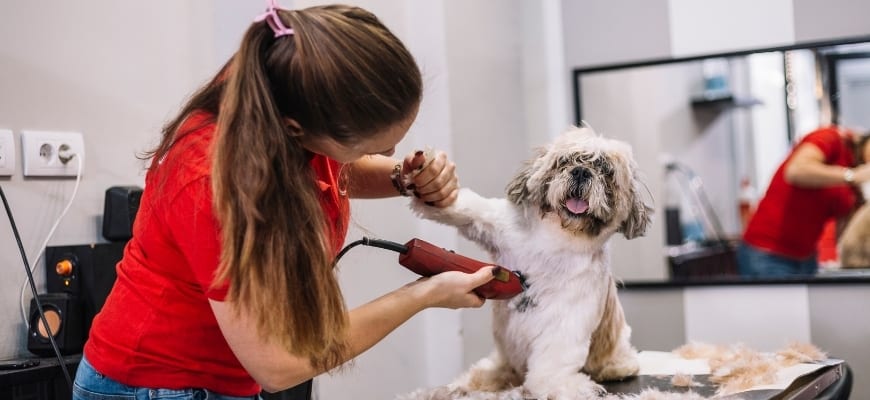
There are lots of different styles of haircut that you can choose for your beloved Goldendoodle, and if the hair is short, it’s much less likely to develop matting issues.
Ideally, you want to get your Goldendoodle shaved and groomed professionally every four to six weeks. The length of time between visits to the groomer depends on several factors:
- The length of your dog’s fur. A longer coat length means more frequent trips to the groomer.
- Your willingness to brush your dog. Frequent brushing prevents mats from forming and means you can get away with less frequent grooming sessions.
- Dogs that love to swim are more prone to matting than those that prefer to stay on dry land, as contact with water makes matting worse. So, if your dog is a swimmer, you’ll want to have him shaved quite short.
Now, let’s discuss how to prevent your Goldendoodle’s fur from becoming matted.
Matted Dog Hair Prevention
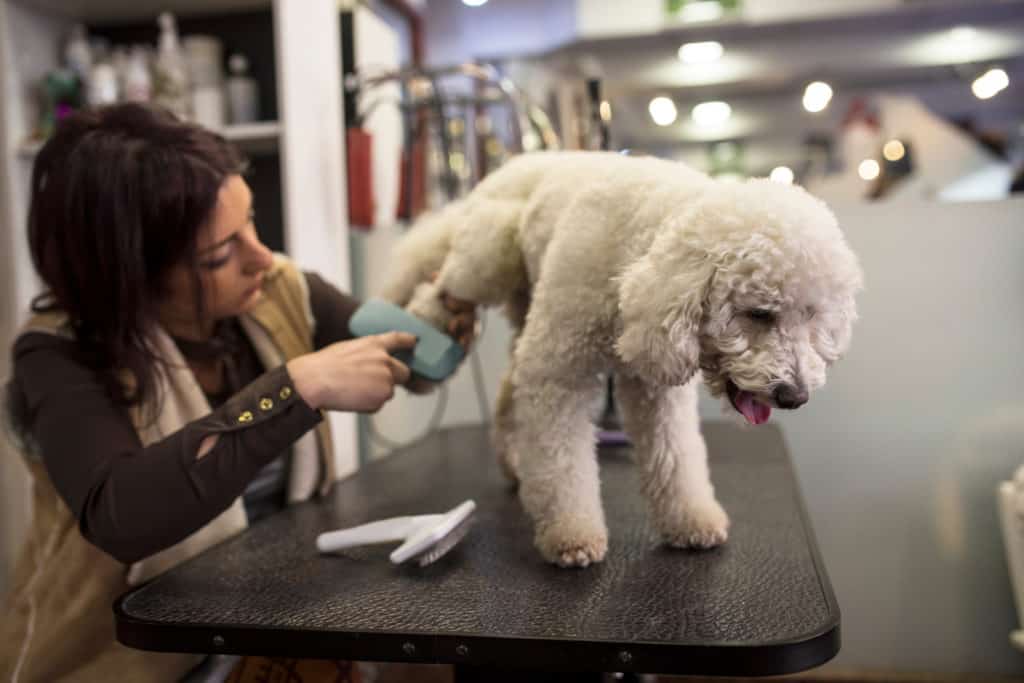
So, now you know what to do if you discover tangles or mats in your Goldendoodle’s otherwise healthy coat. But prevention is much better than cure, and the best way to prevent matting is daily brushing.
What Grooming Tools Do I Need?
There are lots of articles on the web about brushing dogs and dozens of different grooming tools to choose from. But you only need three high-quality tools for proper coat care:
- A metal comb
- A slicker brush
- Pin and bristle brush
Here are a few excellent quality tools that we recommend:
Andis Pet Steel Comb
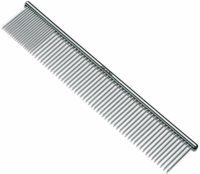
Features: Lightweight, coarse and fine teeth
Coat type: Any
This lightweight metal comb is suitable for use on all coat types and lengths. The tool’s fine and coarse teeth make it extremely efficient for removing tangles, small mats, dirt, and loose fur.
As you work on your dog’s fur, use the coarse side of the comb to remove tangles and fluff up the coat. The finer side of the comb is perfect for use on the dog’s more sensitive areas, including the face, rear end, and paws.
The tool is made from high-quality, durable stainless steel that doesn’t bend or rust. Also, the comb is ergonomically designed to be comfortable in your hand, even during the longest brushing sessions!
You get a 12-month guarantee with this excellent quality, professional standard comb.
Hertzko Self-Cleaning Slicker Brush
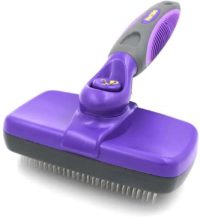
Features: Lightweight, steel bristles, anti-slip grip, self-cleaning
Coat type: Medium to thick
This self-cleaning slicker brush from Hertzko is designed to provide superior performance, and the self-cleaning function saves you time and hassle, too.
The brush has smooth metal bristles that glide through your Doodle’s coat without pulling or snagging. The flexible bristles won’t break or bend, and they retract inside the body of the brush when it’s not in use, preventing damage when in storage. When the brush isn’t in use, you can hang it up for safe storage.
For the Doodle parent’s comfort, the brush handle is strong, covered with non-slip rubber, and even features a handy thumb rest, making the grooming tool easy to hold.
This grooming tool is superbly designed to get rid of loose hair, promote better blood circulation, and detangle the coat. After grooming, simply push the button to retract the bristles, and empty the contents into the trash.
Safari by Coastal Pin & Bristle combination Brush
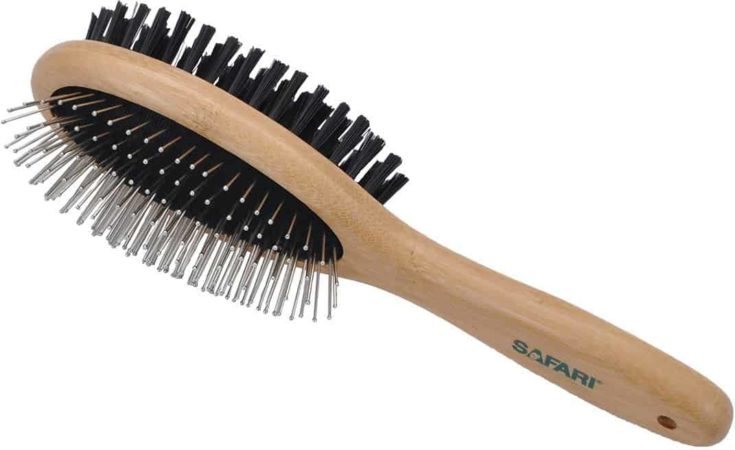
Features: Eco-friendly bamboo handle that gives you a secure, comfortable grip while brushing your furbaby
Coat type: Medium
The double-sided Safari brush features a pin brush on one side and a soft-bristle brush on the other. That’s a great way of saving both storage space and cash.
This grooming tool is excellent for Goldendoodles with short clips and it’s handy for finishing off the job. However, the pin bristles aren’t firm enough to get through a thick, dense coat. The pins have rounded ends that can get through the coat without scratching the skin. The bristle side of the brush is perfect for adding shine to the top of the coat and gathering loose hairs that are left on the top of the coat.
We love the responsibly-sourced, premium quality bamboo handle that offers a gorgeous luxury alternative to silicone or plastic. Also, you can choose from several different sizes of brushes to suit your Goldendoodle.
How To Brush Your Goldendoodle To Prevent Future Matting
Dogs with curly coats are especially prone to developing mats, so ideally, you should brush your Goldendoodle every day to keep matting at bay. Even straight-coated and wavy-coated Doodles, and those with a short clip, need regular brushing, preferably every couple of days.
If you’re planning on bathing your Goldendoodle to get his coat clean, remember to brush him before you get his fur wet. Wet mats are impossible to remove and wet fur is much more prone to matting than dry hair.
Step 1 – Combing And Coat Detangling
Start by combing sections of the dogs hair with the metal comb. If the coat has tangles and mild matting, you’ll find it beneficial to use a detangler spray or some corn starch, as described above.
Work from nose to tail, remembering to comb the dog’s legs and the outer coat. Always comb in the direction of hair growth and be careful not to pull or tug at the dogs fur.
Use your fingers to gently split the mat, and then carefully comb it out, working from the tip of the hair to the root.
Step 2 – Brush Your Goldendoodle
Goldendoodles with wavy or straight coats should be brushed with a pin brush to remove loose hair. Use smooth, short strokes, stopping to clean the brush and remove excess hair every few minutes.
If you have a curly-coated Doodle, brush him with the slicker detangling brush. Go slowly, making sure that you get right down to the dog’s skin where mats are most likely to form. Be careful that you don’t press down too hard or you might scratch the skin.
Step 3 – Finishing Touches
Complete the job by using the bristle brush.
Work your way over the whole dog, making sure that you pick up all the floating hairs that are sitting on top of the coat.
In Conclusion
I hope you enjoyed our guide to dealing with your Goldendoodle’s matted hair. Don’t forget; sharing is caring!
The most effective way for a Doodle parent to prevent mats in your pet’s coat is to brush the dog regularly. Basically, the curlier and longer the dog’s coat is, the more frequently you must brush him. So, a curly-coated Doodle must be brushed every day. Also, you should have your Goldendoodle shaved every four to six weeks. Keeping the coat short can be very effective at stopping tangles, as shorter hair is much easier to brush.
Did you try the cornstarch trick to deal with small mats in your dog’s coat? Did it work for you? Tell us in the comments box below!